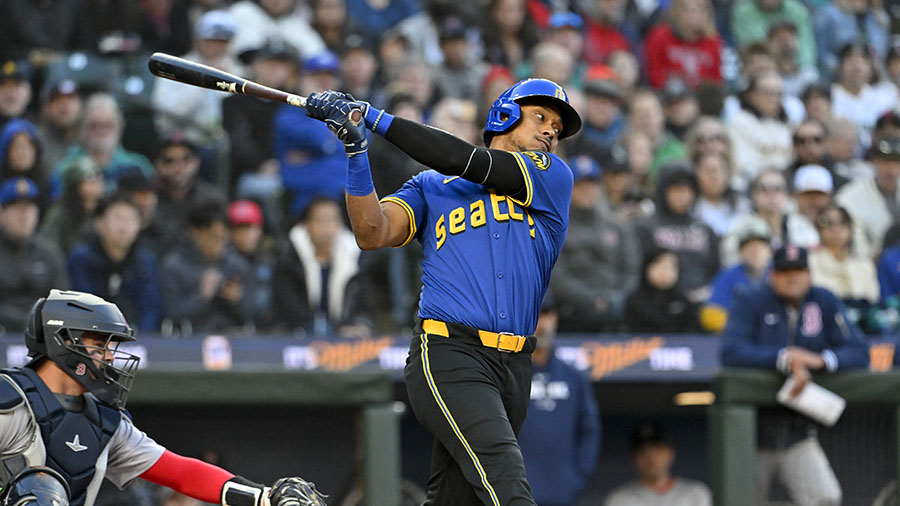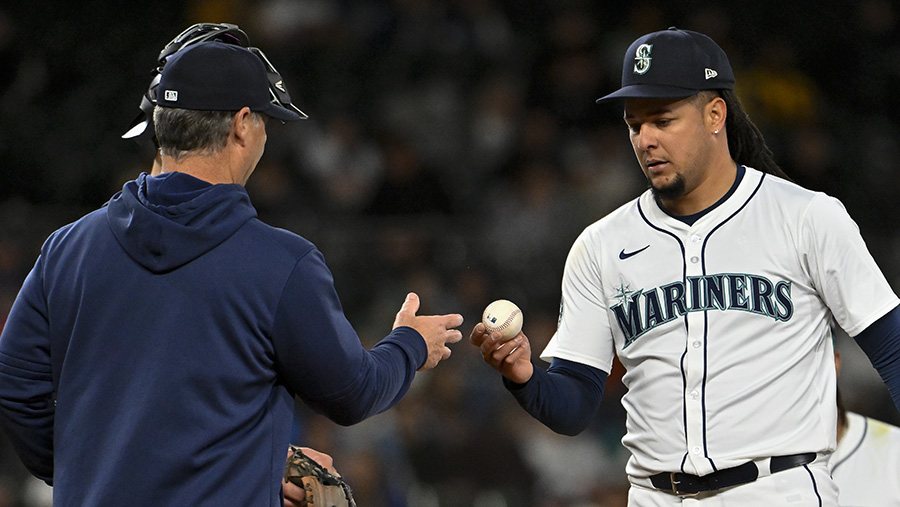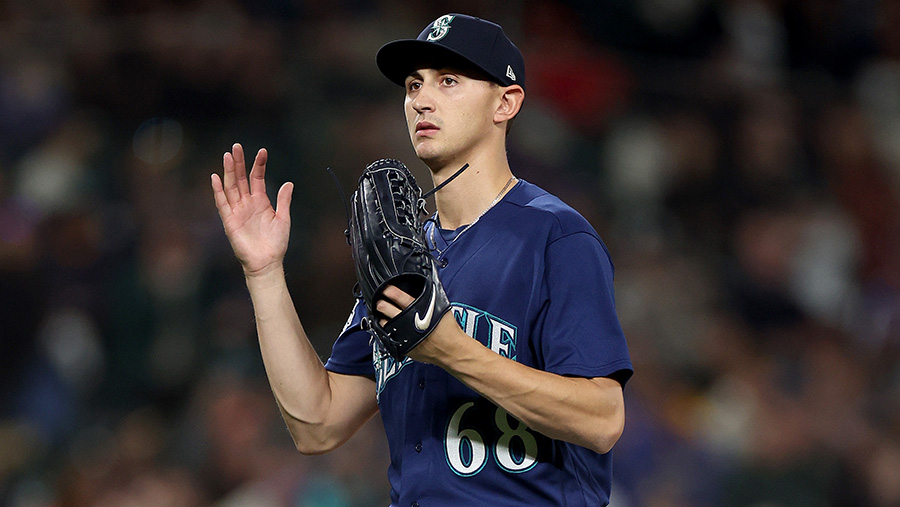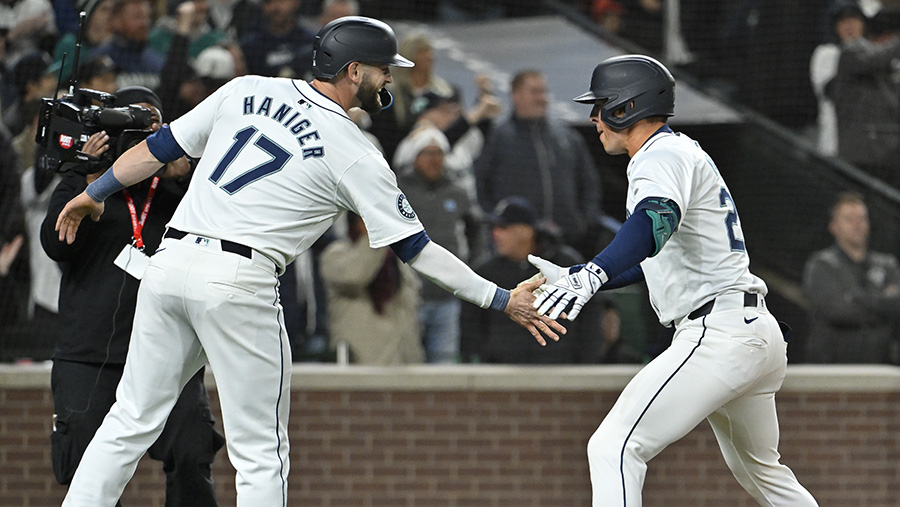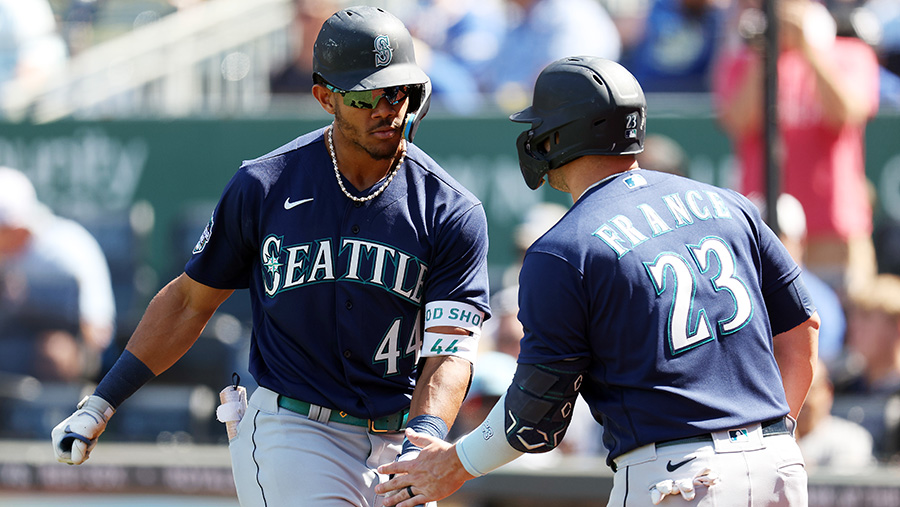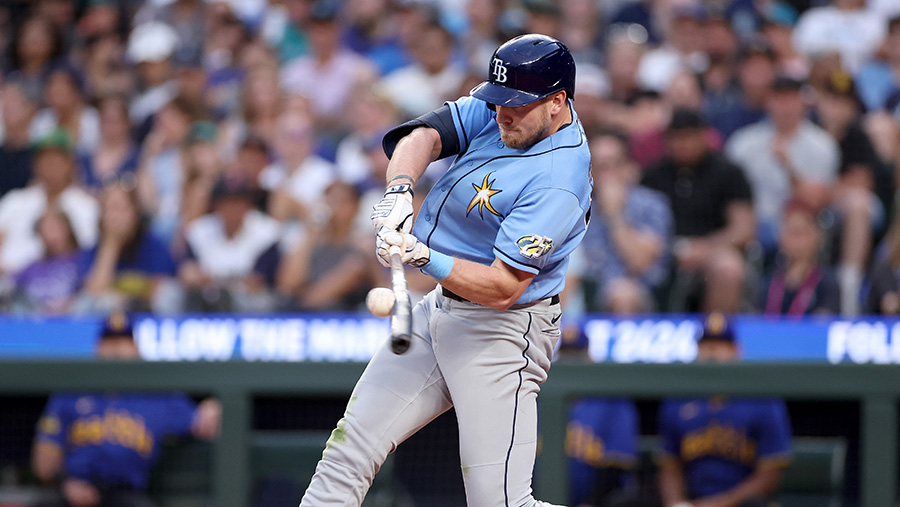Mariners who will be most impacted by new rule changes in 2023
Feb 15, 2023, 1:04 PM

Mariners reliever Andrés Muñoz celebrates a win with catcher Cal Raleigh on Oct. 7, 2022. (Vaughn Ridley/Getty Images)
(Vaughn Ridley/Getty Images)
When you watch the Mariners play this year, it will look mighty different.
That’s not necessarily because of new faces like outfielder Teoscar Hernández or second baseman Kolten Wong, but rather that there are some pretty drastic rule changes being implemented across baseball. All in all, there are five major changes to the game that should have major impacts on the game.
Spring training start brings new rules — pitch clocks, shift limits
For a breakdown of the rule changes, ESPN’s Jesse Rogers, who joined Seattle Sports’ Bump and Stacy on Tuesday (listen to the conversation here), wrote a fantastic primer on the specifics of the rules, how they’re being implemented and what the reasoning for the changes are. You can read that full breakdown here.
For this piece, we’ll be looking at the new rules from more of a Mariners-centric lens.
Let’s dive into which Mariners players will be impacted the most by these new rule changes.
The shift
One of the biggest rule changes is that of the defensive shift, or rather lack thereof.
Over the years, when lefty batters have hit, we’ve seen three infielders on the right side of second base with an infielder in shallow right field and another either behind second base or a few steps beside it to the first base side. Not anymore.
From Rogers’ story: “At the time a pitch is thrown, all four infielders are required to be on the infield dirt (or infield grass) with two on each side of second base. Players will be able to move as soon as the ball leaves the pitcher’s hand. Originally, infielders who began the game on one side of the field would not be allowed to switch to the other side for the entirety of the game, but that was revised to just each inning – unless there’s a mid-inning substitution. In other words, a player who starts an inning at first or second base has to remain on that side of the field for the whole inning but can switch to short or third base the next inning. If there’s an injury mid-inning, then the infield can be reset.”
So yeah, there will be some movement and whatnot among defenses, but the goal is for there to be more action and higher batting averages across baseball. Who this impacts the most from an offensive standpoint is those who hit left-handed.
On the Mariners, three young hitters could benefit from this new rule.
Slugging catcher Cal Raleigh, a switch-hitter, was shifted against at the fourth-highest rate in baseball last season while hitting left-handed, per Statcast.
“Big Dumper” certainly put together a great offensive season, blasting 27 home runs – which led all catchers – while driving in 63 runs, but Raleigh hit just .211 while pulling the ball at roughly a 38% clip and going up the middle about 46% of the time, per Baseball Reference. Both those areas were prime defensive shift locations, but with these new rules, that shouldn’t be the case.
🗣️ IT’S CAL! pic.twitter.com/sFBsZNs1Fj
— Seattle Mariners (@Mariners) August 30, 2022
Additionally, outfielders Taylor Trammell (15th-highest shift rate) and Jarred Kelenic (37th) were among the most shifted-against players in the league in 2022. Neither have found their offensive footing at the big league level in their first two MLB seasons, but having a higher chance of success while pulling the baseball or going up the middle could help those two establish themselves in 2023.
From a defensive standpoint, Wong and shortstop J.P. Crawford will have more of a spotlight on them with the new shift limitations.
Wong explained why he’s in favor of these rule changes during a recent interview with Wyman and Bob (link to story below).
Kolten Wong excited both to join Mariners, play with new shift rule
Bigger bases/pickoff limitations
Let’s stick with the offensive side of the game.
MLB wants there to be more action on the basepaths with more stolen base attempts. As a result, bases have increased from 15 inches on each side to 18, a change that also is being made to increase safety.
“I think between all these rules, we’re gonna see an increase in stolen base attempts. (MLB) saw that in the minors. And when we say an increase for the traditional fans here, they’re not saying it’s going to be like every runner is going to take off,” Rogers told Bump and Stacy this week. “They’re saying that the increase is just going to return the levels to previous years going back to like the ’70s, ’80s, ’90s, 2000s. So it’s not going to be some crazy type of run game, we’re just going to get back to some of the stolen base attempts we used to see in baseball … We used to see 100 stolen bases a year would lead the league. We’re nowhere near that. So they want to get back to something like that, the fast guys getting to 70 or 80 stolen bases a season.”
Additionally, pitchers can now only attempt pickoffs or “disengage the rubber” twice per plate appearance. That resets with every plate appearance or if a baserunner advances during a plate appearance via stolen base, passed ball or balk.
From Rogers’ story: “Pickoffs are one version of a ‘disengagement,’ which consists of any time the pitcher makes a pickoff attempt, fakes a pickoff, or simply steps off the rubber for any reason, as well as when the defense requests time. Pitchers are allowed two disengagements per plate appearance without penalty. The disengagements rule resets if a runner or runners advance a base within the same plate appearance.”
So who on the Mariners will that impact (aside from pitchers and catchers) the most?
Star center fielder Julio Rodríguez led the team as a rookie with 25 steals last year on 32 attempts, emerging as a true power-speed threat. Utility guys Dylan Moore (21 for 29) and Sam Haggerty (13 for 14) were right behind him on the Mariners.
This camera angle of Julio Rodriguez's steal is beautiful 😍 pic.twitter.com/aNvMI9GLbF
— FOX Sports: MLB (@MLBONFOX) July 2, 2022
Kelenic played just 54 MLB games last year, but he stole five times in seven attempts and has swiped 50 bags in 289 career minor league games.
Additionally, Wong stole 17 bases in 23 tries last season and has stolen 117 bases over 10 MLB seasons.
With the pickoff limitation, that can allow baserunners to get better jumps when stealing if they know a pitcher is out of attempts. If a pitcher picks off/disengages with the rubber for a third time, they must get the baserunner out, otherwise it’s a balk and the baserunner gets to advance one base.
Pitch clock – pitchers edition
The game of baseball may not have a time limit like football, basketball, hockey or soccer, but it will have a timer of sorts this season.
This year, there will be a pitch clock in MLB, with the goal being to speed up the game and drastically reduce how long a game takes to play.
From Rogers’ story: “Pitchers will have 15 seconds to throw a pitch with the bases empty and 20 seconds with a runner on base.”
The pitch clock begins when the pitcher receives the ball from the catcher or umpire. The pitcher must then start their motion before the pitch clock expires, otherwise the batter is awarded a ball in the count.
“In general, the spirit of the rule is to keep the game moving,” Rogers told Bump and Stacy. “They believe their experiments in the minors show that – 25 minutes cut off game times down there – and they think that’s going to carry over to the majors … They feel like this is the way that the game needs to go, and they feel like in talking to fans over time that fans like it as well. They want 2.5 hour games, not 3.5 hour games, and so the clock is the big one. That’s the big one that players are going to have to get used to right away.”
For the Mariners, they have a few pitchers who on average last year would have cut it close with the new clock.
Star reliever Andrés Muñoz actually was slower than the new pitch clock with no runners on at an average of 15.6 seconds, which was 49th-slowest in MLB, per Statcast. With runners on base, Muñoz was very close to the limit at 19.5 seconds, 70th-slowest in the league.
Fellow high-leverage reliever Paul Sewald was also among the slowest workers in MLB in 2022. He was 50th-slowest in baseball with no one on at 15.5 seconds and 115th with runners on at 18.5 seconds.
Diego Castillo, known for his lengthy pre-pitch routine, averaged 14.1 seconds from catching the ball to starting his motion, 105th-slowest in 2022.
Starter George Kirby, a rookie in 2022, slowed down quite a bit with runners on base at 19.4 seconds, just under the new pitch clock limit. That was 77th-slowest in MLB.
The pitch clock could also have an impact on stolen bases with runners able to potentially time up the pitcher heading to the plate if the clock is running way down.
Sewald spoke about the challenge of adjusting to the new rule when he called in Wednesday from Mariners spring training in Arizona to join Bump and Stacy. You can hear that conversation in the video below.
Pitch clock – hitters edition
The pitch clock will obviously impact the game’s pitchers, but hitters will also have to change their game due to this new rule.
Per Rogers: “Hitters will need to be in the batter’s box with eight seconds on the pitch clock.”
In other words, with no runners on base, hitters have just seven seconds after the pitcher receives the ball from the catcher or umpire to get back in the batter’s box. With runners on base, the batter will have 12 seconds.
Some of the Mariners’ top hitters will certainly need to cut back on their between-pitch routine.
Raleigh (52nd) and Ty France (55th) were two of the slowest hitters in baseball in terms of tempo with no runners on, per Statcast, while Rodríguez was 121st. If those three were to carry over that pace into 2023 with the new rules, they would be in violation, which would result in a strike being added to the count.
With runners on base, Crawford (124th), Wong, Moore and Eugenio Suárez (ranked in order 302-304) were all over the new limit last season, as well.
More Mariners coverage from Seattle Sports
• Drayer’s Mariners spring training preview: What we’ll be watching
• Mariners’ Julio Rodríguez star of Topps cards boxes, commercial
• Fann: Mariners’ top spring training competition resides in bullpen
• Mariners’ Matt Brash’s slider may be ‘best pitch’ in MLB history
• Mariners spring training radio schedule on Seattle Sports





